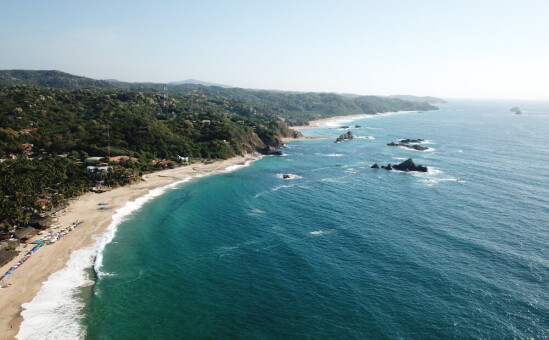Experience Tet in Vietnam: A new year to remember
Tet in Vietnam is all about traditions, customs, colors, and food. Learn all about it in our article and find out where you can catch the fireworks.

For most of us, the New Year ball drops on the 1st of January. In Vietnam, while this is still a significant date, there is something even more special to the locals: their own New Year, also known as Tet. Tet follows the Lunar Calendar and falls in either January or February (the date changes as each month in the Lunar Calendar only has 29 or 30 days, based on the phases of the moon.) Tet is taken much more seriously than the widely celebrated Western New Year that is based on the Gregorian Calendar, and it is the biggest, oldest, most meaningful and important holiday to the Vietnamese.
While the day possesses the same basic meaning as the Western New Year – which is all about the transition from the old to the new, for the Vietnamese, Tet is a time of tradition, religion, family and customs. The country starts preparing for the occasion starting even a month before, and the actual holiday lasts from 7 to 10 days. Tet in 2020 falls on the 25th of January.
Jump to:
1. Symbolic colors and decorations for Tet around Vietnam
2. Tet customs and traditions
3. How to celebrate Tet
4. Classic foods to eat during Tet
5. Visiting Vietnam during Tet
6. Where in Hanoi to celebrate Tet
7. Where in Ho Chi Minh City to celebrate Tet
The country puts on an alluring red dress with golden embroidery
Tet is a time of warm and bright colors! For about a month leading up to Tet, the whole country seems to get washed with five main colors: red (believed to represent good luck), gold, yellow, orange and pink. These colors are mainly from flowers that show up during this time such as apricot and peach trees, and they appear everywhere, from inside homes, to doorsteps; coloring the sidewalks and above highways.
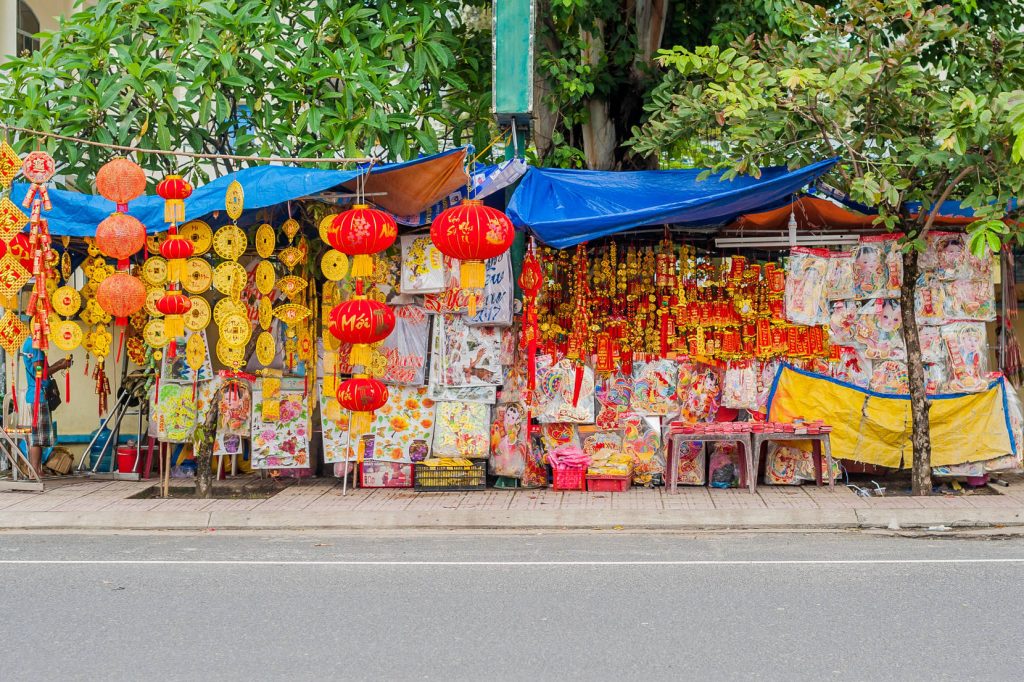
Lanterns, other ornaments, tapestries, and banners decorate the streets and houses, and festive (and loud!) music plays in malls and stores, drawing in bystanders to seasonal sales that are hard to resist. Markets are bustling with people trying to get their holiday shopping done on time.
That’s not all. The Tet decorations are themed around a different animal each year. According to Vietnamese tradition, there are twelve animals of the zodiac, and each one represents a Lunar Year. Once the end of the zodiac is reached, the cycle resets. 2020 is the year of the rat, so you will be seeing a lot of those! In decorations, of course.
Sending away the Kitchen Gods and closing off all debts
Tet is really just a time for the Vietnamese to get in touch with the customs and traditions they grew up with. There are plenty of crucial moments leading up to Tet that households partake in. A major one, for example, occurs on the 23rd of December of the Lunar Calendar. This day seems to mark the beginning of the entire holiday and is called Dua Ong Tao Ve Troi which roughly translates to “Bidding Farewell to the Kitchen Gods” day.
Many Vietnamese families have a small shrine dedicated to the Kitchen God in their kitchens and believe that through this shrine, the Kitchen God keeps an eye on the family, records all their behaviors, and reports the good and the bad to the Jade Emperor once a year on this day. To send the Kitchen God off with a good impression, families will get together and clean the kitchen, burn incense, and make some traditional Tet food such as Chung and Tet cakes to send off with the Kitchen Gods as offerings.
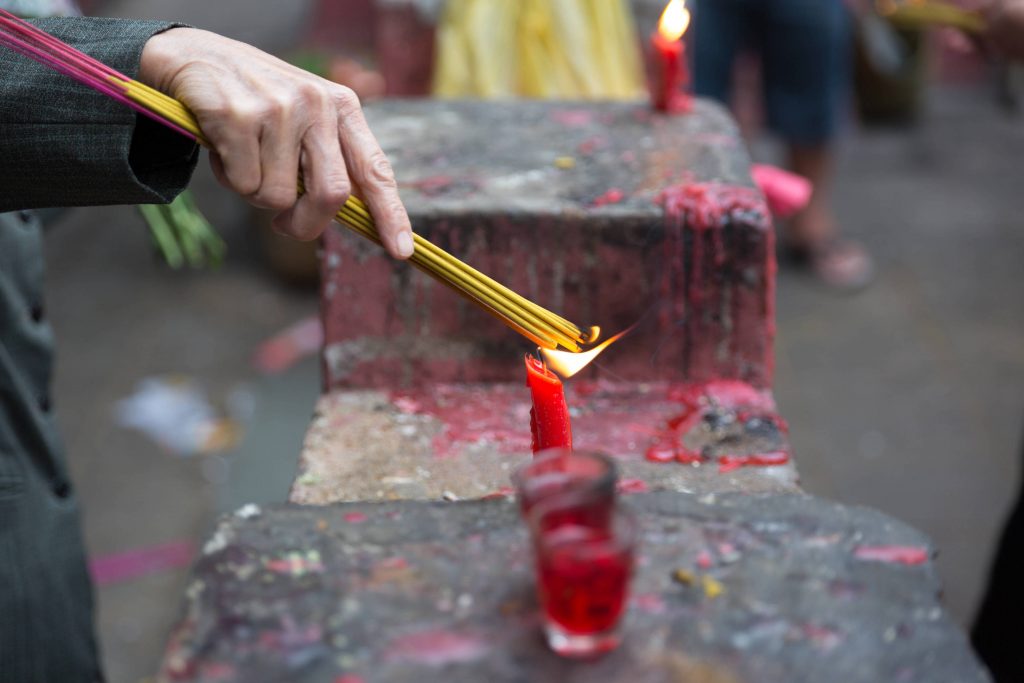
Another important moment falls on the 31st of December of the Lunar Year – Tat Nien. As this day marks the end of the year, ideally, everyone must complete all things left undone from the previous year. This could include paying any outstanding debts or resolving a conflict with a colleague or a distant family member. It is also time to forget about all the negative things that happened the previous year and to keep an open and positive mind for what is to come.
Cleaning, not only the house, but also the mind and body, is an important aspect of Tet. The locals follow a mindset of “out with the old and in with the new,” and collect up any trash, dust and old items before New Year’s Eve. Some may even repaint their homes and redecorate, in an act thought to bring luck to the owner. However, it is very much taboo to do so on the first three days of Tet as it is believed that sweeping the house would mean you are sweeping your good fortunes away. This act is reserved for the week before the day of Tet, or any time after the first 3 days have passed.
Just when it is time for the ball to drop, at midnight of New Year’s Eve, is when religious locals begin praying to their Gods and their ancestors, asking for a year full of health, happiness, luck and prosperity.
Happy New Year!
And then it’s Tet. Fireworks, parades, cultural performances, food festivals… streets get congested with those celebrating day and night but this doesn’t mean the family customs are over. From the first to the sixth day of the Tet, there are more obligations for the Vietnamese.
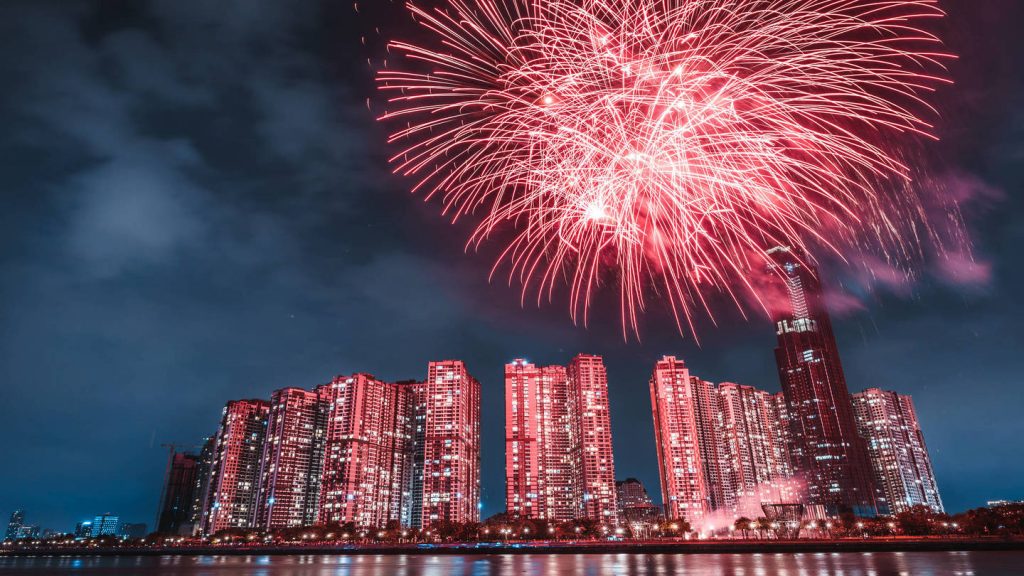
The first day of the New Year is called Tet Cua Cha (Tet of the Father) and this day is reserved for people to visit the paternal side of their families. Tet Cua Me (Tet of the Mother) follows the next day. The third day is called Tet Cua Thay (Tet of the teachers), and in Vietnam, teachers are held in very high regard. The third day is therefore all about showing one’s gratitude to their teachers who bestowed upon them valuable knowledge.
During these visits, people share with one another New Year’s greetings and wish good health and fortune for the upcoming year. Another exciting (and much loved) custom is the act of handing out red envelopes stuffed with cash to one another. Li Xi, or lucky money, is given by elders to children, or generally those younger to you, even if they are adults. Inside the envelope you will find money ranging from a few thousand to even millions of Vietnamese Dong.
Another important ritual is called Xong Dat – the first visit to a house. It is believed that the first guest stepping foot inside a house has a huge impact on how the following year will pan out for the residents, so naturally you’d want to invite someone optimistic and cheerful in addition to possessing other positive personality traits. The Vietnamese also believe that it is good luck (for the whole family) if the zodiac animal of the first guest matches that of the owner of the house.
The fourth, fifth and sixth days are reserved for hanging out, drinking, gambling or traveling somewhere nice with family and friends. Pagodas are also quite lively during this time as the Buddhist Vietnamese spend their time praying to their Gods and asking for good fortune, love and happiness in their lives from the coming year onward. Although after these few days the celebrations cool down and people go back to work, etc., the real end of the holiday is marked by the 15th of January on the Lunar Calendar. This day, Tet Nguyen Tieu, is held alongside January’s full moon, and things get back to normal.
Let’s not forget the delicacies…
A must make (and of course, eat!) during Tet is Banh Chung. Chung cake is made of sticky rice stuffed with a mixture of mung bean and pork (yum), wrapped in a banana leaf and shaped like a square. While families usually sit together to make this cake a day or two before Tet, it is now very popular to forgo this very time consuming tradition and just buy it.
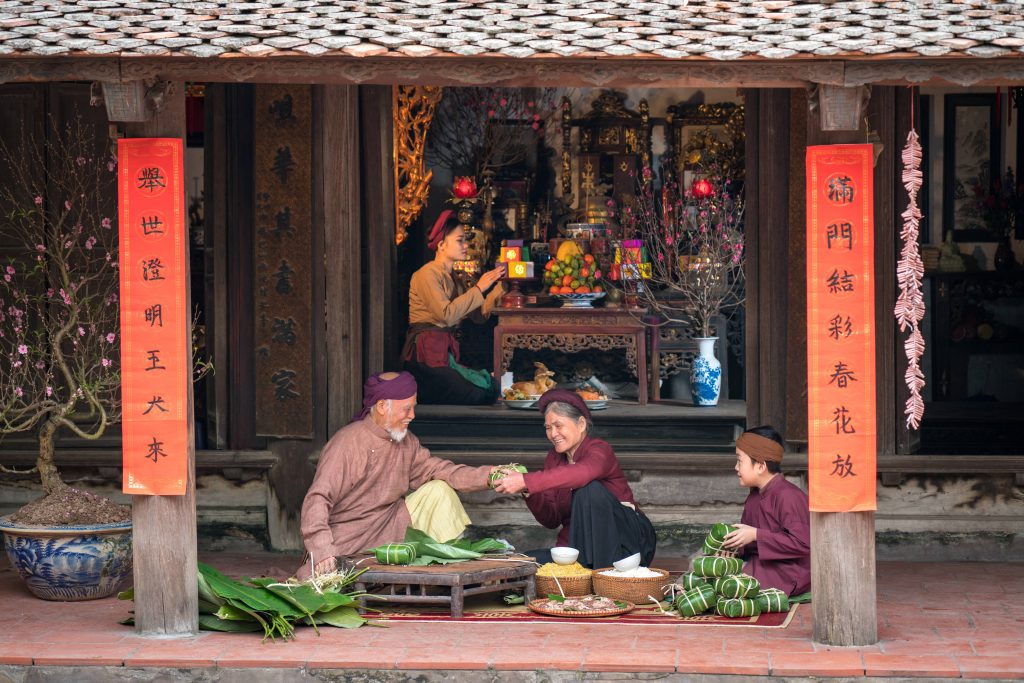
Other traditional dishes that show up during Tet time include gio chia (Vietnamese sausages made of either pork or beef), thit kho trung (a delicious dish made of braised pork and egg), mut tet (a snack bag of candied fruits such as ginger, carrot, coconut, lotus seed, etc.), and dua muoi (pickled veggies including onions, carrots, garlic, turnip, etc.) The dua muoi are often condiments served alongside main courses during the holiday.
Visiting during Tet may be inconvenient, but it’s worth it
The three weeks leading up to Tet gets hectic! This is when people take their leave from work and decide to head back home to the countryside to visit their families. Because of this sudden surge in people leaving major cities, transport almost gets fully booked. If you plan to travel during this time, best book all your transportation in advance and be prepared to pay a premium. If you have a domestic flight, remember to head to the airport about 5 or 6 hours earlier than usual – believe us when we say the lines get insane!
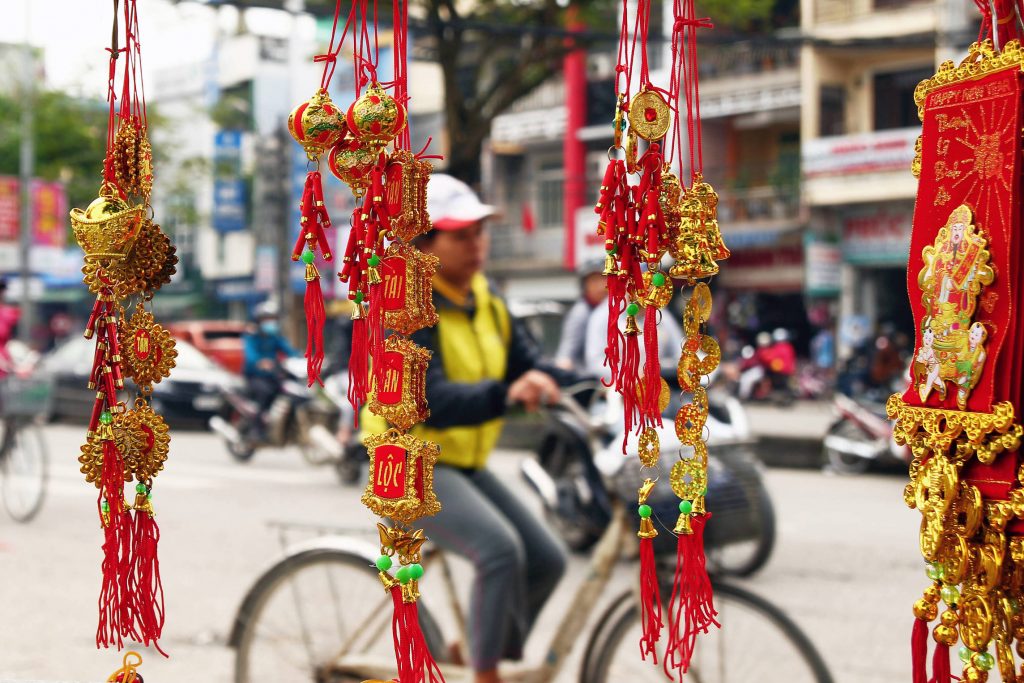
Funnily enough, the two main cities, Hanoi and HCMC almost end up deserted and apocalyptic looking. This means hotels are normally abundant during this time, but perhaps less so in other, smaller cities. Many tourist attractions, for example museums, are closed during Tet and as are many dining and drinking establishments, usually on the 30th December and 1st of January on the Lunar Calendar. Markets, supermarkets and malls join them as well.
While you will have to deal with these inconveniences, you can still experience the country as they celebrate their most important and meaningful holiday, giving you much more insight to the Vietnamese culture than usual.
From colorful firework displays in Hanoi…
If you are traveling to Hanoi, planning ahead what you want to do during this time is a wise idea since many local businesses and tourist sites close during Tet. It’s quite lovely to spend the first 1-3 days of Tet just walking around the city, going wherever your feet take you. Most locals are spending this time visiting their families, so you won’t have much to do, but you can enjoy the roads without the crazy sea of motorbikes.
Check out pagodas such as Tran Quoc pagoda or the Temple of Literature where you can partake in some religious rituals such as lighting incense, praying and leaving offerings at altars. You must also visit the flower gardens and markets. Check out Nhat Tan Flower Garden, Quang Ba Flower Market, Hang Luoc Flower Market to be overwhelmed by bright colors and subtle smells.
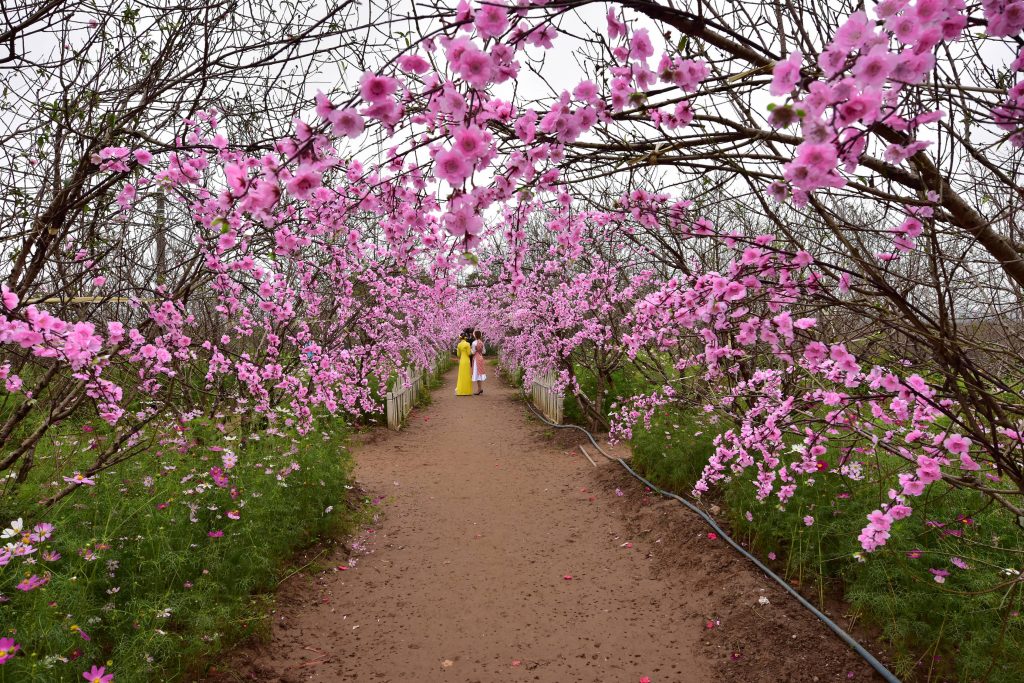
Before Tet is when you should visit Dong Xuan Market, which will be overflowing with people buying clothes, food and decorative items. Colorful ornaments and goods will be spilling off the shelves – plenty of Vietnamese foods such as jams made of coconut, ginger, sweet potato, and more, candies, salted vegetables, Banh Chung, and other Tet delicacies.
Hang Ma Street in the Old Quarter is where you need to go if you want to take some beautiful photos for your Instagram – this whole street puts on a red and gold dress, attracting travelers and locals alike with its festive Tet vibe. You can buy many Tet-related decorations and ornaments here as well.
Lastly, we know you’re looking for fireworks and there are five awesome locations to catch sight of these: Hoan Kiem Lake, Thong Nhat Park, Lac Long Quan flower garden, Van Quan Lake, and My Dinh National Stadium.
…to floating flower markets in Ho Chi Minh City
If you head to HCMC during Tet time, don’t miss out on the opportunity to see the only floating flower market you can see here. Yearly, on the 25th of December of the Lunar Calendar, a seasonal floating flower market forms in the banks of Ben Binh Dong in District 8. Many traders from the south of Vietnam and even from other regions such as Cambodia, bring their colorful flowers to sell to the residents of HCMC that flock here to make their purchases.
To do your ornament shopping, head to Hai Thuong Lan Ong street in District 5 and you will find plenty of lanterns, tapestries and the like. For a beautiful flower display during Tet, head over to Nguyen Hue Boulevard (a famous pedestrian street in HCMC, where the beautiful cream colored City Hall looms over from the northern end) that gets lined up with all kinds of flowers from orchids, daisies to apricot flowers and lotuses.

Nguyen Hue is also famous for cultural parades and fairs that occur frequently during the year. The Phu My Hung flower fair is another must visit. In the evening, the Starlight bridge puts on a light display making the place even more beautiful.
Firework shows occur in six areas of the city. Head to the Thu Thiem Tunnel that connects Districts 1 and 2 for a show over the river. Dam Sen Park joins in from District 11, and the other firework shows are way further away: in Cu Chi District, Can Gio District, Binh Chanh District and Hoc Mon District.
While Tet, overall, is not the easiest time to travel in Vietnam due to the inconveniences you may face, it is still an exciting time and will provide you with great insight into the local culture. Head towards the more off-the-beaten-track destinations to experience Tet with the locals and their families. Remember to also stay till Tet passes, so you can engulf yourself in the hectic chaos of the cities as the residents flood back in.



